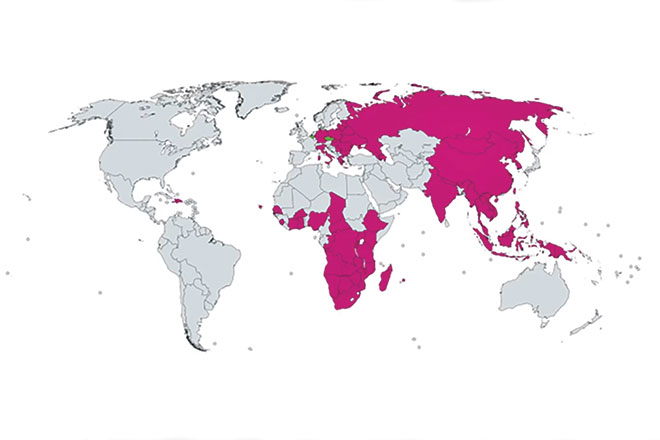Above:Global ASF Overview – The SowBridge series (July 2022). Presented by Vincent der Beek, Pig Progress. Magenta indicates ASF occurrence 2007-2022 (65). Green indicates eliminated ASF after 2007 (2).
In September, the World Organisation for Animal Health Regional Representation for Asia and the Pacific released the report ‘African swine fever in wild pigs in the Asia and Pacific region’.
It was authored by Brendan Cowled, Madalene Oberin and Alison Hillman from Ausvet, Michael Ward from the University of Sydney and Caitlin Holley from the World Organisation for Animal Health.
While African swine fever in wild pigs has been well researched in Europe, parts of the Caucasus and central Asia, there have been limited studies on ASF in domestic and wild pigs in the Asia and Pacific region.
Given the ecological, population and geographical differences between the areas, it is unknown whether existing studies can be applied to the Asia and Pacific region.
The report – commissioned by the Standing Group of Experts on African swine fever in Asia and the Pacific – aimed to:
- Review current knowledge of ecology and distribution of wild pigs in the Asia and Pacific region and their role in swine disease epidemiology and
- Provide recommendations to manage wild pig populations, their interface with domestic pigs and other actions to contribute to the control and prevention of African swine fever in the Asia and Pacific region.
In the Asia and the Pacific region, there are 12 species of wild pigs present from the sus, babyrousa and porcula genera.
Sus scrofa are very common in the region, present as either endemic wild boar or feral in parts of Southeast Asia, Australasia and most of the Pacific.
Due to its ecology, distribution and density, this species was regarded as the most relevant to ASF in the region.
For the 11 locally endemic wild species present in the Asia and Pacific region, ASF threatens these populations with local extinction.
The role of wild pigs in the epidemiology of ASF in the Asia and Pacific region is uncertain.
ASF is only confirmed in s scrofa, bearded pigs or s barbatus and Philippine warty pig or s philippensis.
There is a lack of wild pigs in this region.
In Europe, wild pigs can act as reservoir or spill-over host of ASF.
The report identified the following knowledge gaps on ASF in the Asia and the Pacific region:
- Understanding of how ASF affects different wild pig species in Asia
- Ecology of wild pig species and how this may influence ASF transmission
- Mechanisms of spread and persistence of ASF in wild boar populations and whether wild pigs are spill-over or reservoir hosts, and if so, where
- Importance of carcasses in the transmission of ASF
- The role of climate and time of the year in the Asia and the Pacific region on transmission
- Role of vectors in disease transmission
- Trade and cultural links between sites of importance and how these may influence ASF risk
- Most effective and efficient means of implementing smallholder biosecurity management to minimise transmission of ASF between wild and domestic pigs
- Host density thresholds for persistence of ASF and what level of culling may lead to reduced disease transmission and disease fade-out
- Efficacy of alternate and more efficient control tools for culling pigs in new areas
- Social, cultural and practical acceptability of alternative disease control tools.
To address these knowledge gaps across the Asia and Pacific region, a total of fourteen recommendations were made.
For full details, the report can be accessed at rr-asia.woah.org/en/events/reporting-on-african-swine-fever-and-wild-pigs-in-asia-and-the-pacific/
A presentation is also available via this link.
Some of the recommendations are already being addressed in Australia.
Other knowledge gaps stated in the report that could be addressed included the distribution and population density of wild pig species and the epidemiological role of wild pigs in an ASF outbreak.
In Australia, the Australian Bureau of Agricultural Resource Economics and Sciences is currently working to update the geographic distribution and density of feral pigs in Australia.
More information about this work can be found at agriculture.gov.au/abares/research-topics/invasive-species/distribution-and-impacts
The Australian Animal Disease Spread Model has also been developed for African swine fever.
This model simulates the spread and control of ASF in Australian domestic and feral pigs.
More information can be found at minerva-access.unimelb.edu.au/items/61021c1d-b7c2-5e82-b749-b4948c0f387c
Awareness, preparedness and prevention through good biosecurity by all land managers will always be the best measures to mitigate the introduction and spread of any disease, including ASF.
Department of Agriculture and Fisheries Queensland recently launched a new interactive online learning course on the prevention and early detection of African swine fever.
It covers the potential impacts of ASF, how to prevent its entry and establishment in Australia, and how to recognise and report signs of ASF.
It can be accessed through Animal Health Australia’s online learning portal aha.canopihr.com.au/auth/login/?returnUrl=%2F and is free.
Having an up-to-date biosecurity plan in place, which includes feral animal management, is vital for all land managers.
Any signs of disease should be reported by producers to the Emergency Animal Disease Hotline on 1800 675 888 or their local veterinarian.
Feel free to contact me at heather.channon@feralpigs.com.au or call 0423 056 045 to discuss your feral pig management issues or any information presented in this article.







